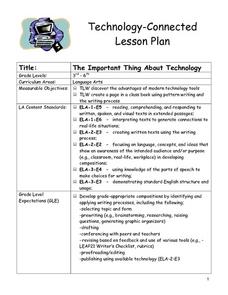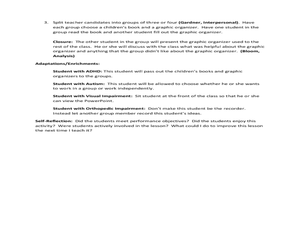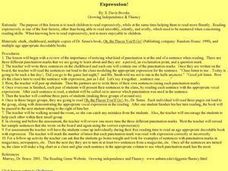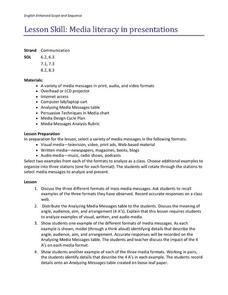Curated OER
Pika Chew
Learners work in collaborative teams with specific roles, use the Internet to research the behavior and ecology of pikas, make predictions about survival rates of pikas in different habitats and organize their data in graphs.
Curated OER
Polluting the Environment
Fourth graders construct mini-ecosystem, pollute the ecosystem, observe, collect, and record data on the effects of these pollutants on their ecosystem, organize data on spreadsheets, create graphs, and design presentations to share with...
Curated OER
Writing for a Purpose in Senior College English
Twelfth graders are introduced to the proper way to write a paper. As a class, they examine and review the four stage process for writing about any topic. Using the topic they choose, they begin to identify the relationship between...
Curated OER
Harriet Tubman Integrated Unit
Students organize facts about Harriet Tubman. For this writing lesson, students research Harriet Tubman, sort facts about her into two categories, and use the information they have found to write about her life in complete paragraphs.
Curated OER
Discovering Mitosis in Onion Roots
Students discover the different stages of mitosis by examining onion roots under a microscope, drawing diagrams of what they see, and organizing collected data in a chart and create a pie graph from their lab data.
Curated OER
An Antidote to Plagiarism
Young scholars discover how to write a research paper without directly copying written material. They read a passage, then record on the board any words that are new for them. They define these words, then organize their facts to create...
Novelinks
Oedipus the King: Organizational Patterns
Designed for teachers of Sophocles' Oedipus the King, this packet provides information about themes and literary devices used in the play. Appropriate for first-time and veteran teachers of Sophocles' tragedy.
K12 Reader
Using Prior Knowledge
Sometimes it's hard to relate to a new text. Teach kids to use their prior knowledge when reading something new with a comprehension exercise. A short passage tells them how to think of their brains like filing systems, and provides five...
Curated OER
Better Body Books, Inc.
Pupils work in groups of 2-3 people to prepare a book about the human body that is suitable for a 3rd, 4th, or 5th grade student.
Curated OER
Second Graders Create Their Own Social Studies Book (Part I, The 5Ws of the Constitution)
Students develop their own social studies textbook using a blank theme book as they complete activities and learning experiences throughout the year. The activities are in art, music, simulations, read alouds, shared writing and a class...
Curated OER
Grade 6 Language Arts Book 3
In this grade 6 language arts book 3 instructional activity, 6th graders read 2 passages and write 4 paragraphs using details from the passages.
Curated OER
HyperStudio Book Reports
Fifth graders create a HyperStudio book report after reading a novel. They work in pairs or small groups to design a HyperStudio stack about a previously-read novel. They use a variety of graphic organizers to have Students gather...
Curated OER
Grade 4 Language Arts Test Book 3
In this grade 4 language arts test book 3 worksheet, 4th graders read a passage and answer 2 questions by writing a paragraph using supporting details.
Curated OER
The Important Thing About Technology
Students assess the advantages of modern technology tools by creating a page in a class book utilizing pattern writing as well as the writing process. They organize and develop a composition on a selected topic after going through the...
Curated OER
Graphic Organizer Lesson
Students investigate how to use graphic organizers. In this literary elements lesson, students are introduced to several types of graphic organizers and their purpose. Students read a book of their choice and complete a graphic organizer...
Curated OER
Expression!
Students organize ways of reading expressively as well as fluently. They encounter books by Dr. Seuss within this lesson plan. Practice, practice and more practice makes perfect. Punctuation marks are reviewed for accuracy.
Curated OER
Jeffrey and Sloth
Students listen to the story Jeffrey and Sloth and explore the six traits of writing. In this six traits of writing lesson plan, students practice doodling as a method of brainstorming ideas. Students then discover the importance of...
Curated OER
American Born Chinese
Students make thematic connections and organize their ideas using a Venn Diagram. In this Venn Diagram instructional activity, students compare 3 different stories from a novel and fill in a Venn Diagram. Students then discuss their...
Curated OER
Digital Picture Books
Second graders create digital picture books reflecting their experiences during the school year on field trips and various classroom activities. Using digital pictures taken during the year, they write captions for each picture and...
Curated OER
Upside-Down Books
Young scholars read various examples of literature. In groups, they brainstorm a list of views that go against what was in one of the stories. They illustrate the opposite ideas and compile them into a class book. They use each other...
Curated OER
Using Words as a Way into Rick Riordan's The Lightning Thief
Use the Visual Thesaurus to predict the subject matter of Rick Riordan's book The Lightning Thief. A pre-reading activity encourages middle schoolers to use context clues and word meaning to discover what the book is about. After...
BW Walch
Daily Warm-Ups: Grammar and Usage
If grammar practice is anywhere in your curriculum, you must check out an extensive collection of warm-up activities for language arts! Each page focuses on a different concept, from parts of speech to verbals, and provides review...
Curated OER
Math Investigations 2
Young mathematicians practice measuring and graphing skills while working in groups to measure objects found in the classroom. Using their measurements, they create one bar graph displaying the lengths and another displaying the widths.
Curated OER
Media Literacy in Presentations
Middle schoolers study the three types of mass media messages: visual media, written media, and audio media. After a class discussion which has them list examples of each, learners get into pairs and work on analyzing the "Four A's" in...























